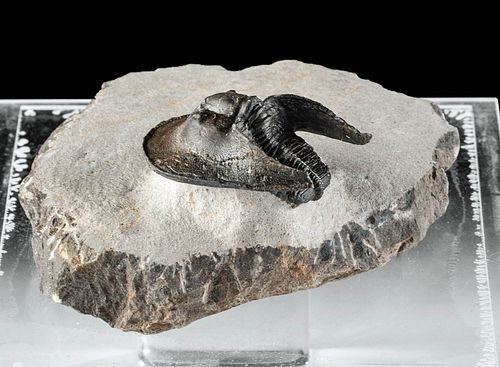Fossilized Harpes Trilobite w/ Stone Matrix
Lot 47
About Seller
Artemis Gallery
686 S Taylor Ave, Ste 106
Louisville, CO 80027
United States
Selling antiquities, ancient and ethnographic art online since 1993, Artemis Gallery specializes in Classical Antiquities (Egyptian, Greek, Roman, Near Eastern), Asian, Pre-Columbian, African / Tribal / Oceanographic art. Our extensive inventory includes pottery, stone, metal, wood, glass and textil...Read more
Estimate:
$400 - $600
Absentee vs Live bid
Two ways to bid:
- Leave a max absentee bid and the platform will bid on your behalf up to your maximum bid during the live auction.
- Bid live during the auction and your bids will be submitted real-time to the auctioneer.
Bid Increments
| Price | Bid Increment |
|---|---|
| $0 | $25 |
| $300 | $50 |
| $1,000 | $100 |
| $2,000 | $250 |
| $5,000 | $500 |
| $10,000 | $1,000 |
| $20,000 | $2,500 |
| $50,000 | $5,000 |
| $100,000 | $10,000 |
| $200,000 | $20,000 |
About Auction
By Artemis Gallery
Jun 24, 2021
Set Reminder
2021-06-24 10:00:00
2021-06-24 10:00:00
America/New_York
Bidsquare
Bidsquare : VARIETY SALE | Ancient & Ethnographic Art
https://www.bidsquare.com/auctions/artemis-gallery/variety-sale-ancient-ethnographic-art-7119
Featuring classical antiquities, ancient and ethnographic art. Egyptian, Greek, Roman, Etruscan, Near Eastern, Asian, Pre-Columbian, Native American, African / Tribal, Oceanic, Spanish Colonial, Russian, Fossils, Fine Art, more! All legally acquired, legal to sell. Satisfaction guaranteed. Artemis Gallery info@artemisgallery.com
Featuring classical antiquities, ancient and ethnographic art. Egyptian, Greek, Roman, Etruscan, Near Eastern, Asian, Pre-Columbian, Native American, African / Tribal, Oceanic, Spanish Colonial, Russian, Fossils, Fine Art, more! All legally acquired, legal to sell. Satisfaction guaranteed. Artemis Gallery info@artemisgallery.com
- Lot Description
Ancient Seas, Morocco, Hamar Laghdad Formation, Devonian period, ca. 419.2 to 358.9 Million years ago. A fossilized Harpes trilobite within a stone matrix! This "sea bug" has been prepared with the cephalon slightly raised above and out from the surrounding matrix, as if still scuttling across the ocean floor as it once did! The Harpes genus is characterized by the wide, semicircular brim that protected the cephalon head. The projecting genal spines at the side of the cephalon, are nearly as long as the rest of the body and were thought to act as protection like side armor when these creatures rolled into defensive balls. The dark surface of this trilobite contrasts beautifully with the white stone matrix and is a remarkable specimen to add to any fossil collection! Size of fossil: 1.675" L x 1.25" W (4.3 cm x 3.2 cm); matrix: 3.5" L x 3" W x 1.3" H (8.9 cm x 7.6 cm x 3.3 cm); case: 4.125" L x 4.125" W x 3.25" H (10.5 cm x 10.5 cm x 8.3 cm)
Trilobites are a fossil group of extinct marine arthropods that form one of the earliest known groups of arthropods. The first appearance of trilobites in the fossil record defines the base of the Atdabanian stage of the Early Cambrian period (521 million years ago), and they flourished throughout the lower Paleozoic era before beginning a drawn-out decline to extinction when, during the Devonian, all trilobite orders except the Proetids died out. Trilobites disappeared in the mass extinction at the end of the Permian about 252 million years ago. Trilobites were among the most successful of all early animals, roaming the oceans for over 270 million years!
Provenance: ex-Stein collection, Bloomfield Hills, Michigan, USA, acquired prior to 2010
All items legal to buy/sell under U.S. Statute covering cultural patrimony Code 2600, CHAPTER 14, and are guaranteed to be as described or your money back.
A Certificate of Authenticity will accompany all winning bids.
We ship worldwide and handle all shipping in-house for your convenience.
#164338Repaired with infill or restoration along break lines. Break lines across end of body and extend across left side of cephalon and left brim and tip of left spine reattached. Tip of right spine reattached. Matrix repaired from 4 pieces with faint break lines visible. Displayed in acrylic case.Condition
- Shipping Info
-
All shipping is handled in-house for your convenience. Your invoice from Artemis Gallery will include shipping calculation instructions. If in doubt, please inquire BEFORE bidding for estimated shipping costs for individual items.
-
- Buyer's Premium



 EUR
EUR CAD
CAD AUD
AUD GBP
GBP MXN
MXN HKD
HKD CNY
CNY MYR
MYR SEK
SEK SGD
SGD CHF
CHF THB
THB













